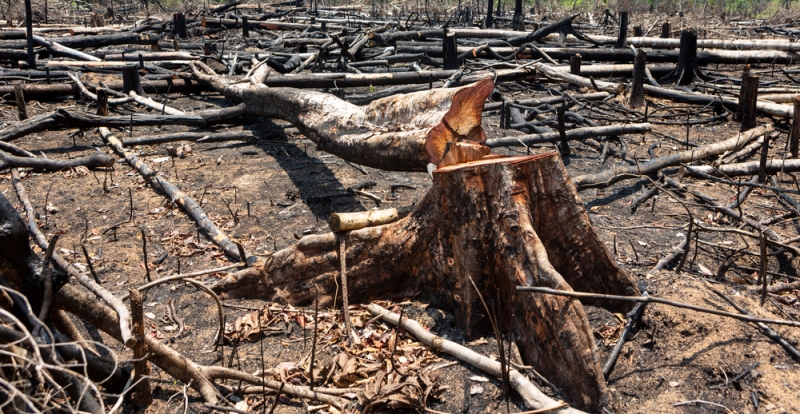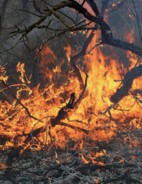
Think about the following questions.
1. How are rainforests different from other kinds of forests?
2. Why are large areas of rainforests typically cut down?
3. What can be done to preserve the world's rainforests?
VOCABULARY PREVIEW
Match each New Academic Word List(NAWL) word with the correct definition.
- tropical _____
- sustainable _____
- precipitation _____
- intensive _____
- agriculture _____
- vegetation _____
- a. plants
- b. of or relating to a warm climate near the equator
- c. rainfall or snowfall
- d. highly concentrated or accelerated
- e. farming and the raising of livestock
- f. possible to continue or maintain
DEFORESTATION

It would be difficult to imagine life without the beauty and richness of forests. But scientists warn we cannot take our forests for granted. By some estimates, deforestation has already resulted in the loss of as much as eighty percent of the natural forests of the world. Currently, deforestation is a global problem, affecting wilderness regions such as the temperate1 rainforests of the Pacific Northwest area of the US and Canada's British Columbia, and more seriously, the tropical rainforests of Central and South America, Africa, Southeast Asia, and Australia.
Deforestation occurs for many reasons. In the temperate rainforests of the US and Canada, large areas of forest have been cleared for logging2 and urban expansion. In tropical rainforests, one of the most common reasons for deforestation, aside from logging, is agriculture. Because the soil in many tropical regions is often nutrient-poor, and since ninety percent of nutrients in tropical forests are found in the vegetation and not in the soil, many farmers practice an agricultural method known as slash3 and burn. This method consists of cutting down the trees of an area in the rainforest and burning them to release their rich nutrients into the soil.
This method is sustainable only if the population density does not exceed four people per square kilometer of land. When this is the case, each farm has enough land to let sections of it lie fallow4 for ten years or more, which is enough time for the land to renew itself. In recent years, however, the population density has often reached three times the optimum5 number. This results in land being used in a more intensive manner with no chance to recover. Under these conditions, slash-and-burn farming becomes only a temporary solution. Within two or three years, the soil becomes depleted6, and the farmer must repeat the slash- and-burn process elsewhere.
Deforestation also causes changes in the Earth's atmosphere. For example, deforestation in tropical areas disrupts the cycle of rain and evaporation7 by removing the moist canopy8 of foliage9 that trees provide. Undisturbed, this canopy traps about twenty percent of the precipitation in the area; when this moisture evaporates, it causes clouds to form, promoting future precipitation. When trees are cleared away, the canopy is lost, and the cycle is disturbed. Rainfall sinks into the earth rather than evaporating into the air, leading to a drier local environment. This can lead to desertification—the forming of deserts and ultimately to rises in atmospheric temperatures.
Deforestation is also partially responsible for rising atmospheric levels of carbon dioxide (CO2). Forests normally decrease the amount of carbon dioxide because the trees consume it and release oxygen. Less forest, therefore, means more CO2 in the atmosphere, especially when trees are burned, which releases even more CO2. About 1.6 billion metric tons of CO2 enter the atmosphere this way every year. For comparison, the burning of fossil fuels releases approximately thirty-three billion metric tons of CO2 per year. These rising levels are a cause for concern because they are expected to be responsible for fifteen percent of the increase in global temperatures up through 2025.
In addition, deforestation causes the extinction of thousands of species of wildlife annually. It is estimated that as many as eighty million kinds of animals and plants make up the total species on Earth, but only about 1.5 million have been studied and named by scientists. Tropical rainforests, which cover about seven percent of the Earth's land, are home to over half of these plant and animal species. If the rainforests disappear, many of these species will become extinct. This means many species will vanish10 before we can discover them.
Is it possible to reverse the devastating effects of deforestation? Many experts think so, but it will require a concerted international effort to protect the remaining forests. It will also require increased awareness, more sustainable consumer habits, and solutions that replace financial incentives for local economies.
New Academic Word List
- temperate 1 : adj. having a moderate climate without extreme temperatures
- logging 2 : n. cutting down trees for wood
- slash 3 : v. to cut violently
- lie fallow4 : idiom. (of farmland) to be left unused
- optimum 5 : adj. the best possible
- depleted 6 : adj. used up
- evaporation 7 : n. the process of changing from a liquid into a gas
- canopy 8 : n. the highest layer of branches in a forest
- foliage 9 : n. the leaves on trees and plants
- vanish10 : v. to disappear
READING COMPREHENSION
A ‣ Mark each statement as true (T) or false (F) according to the reading.
- Only eighty percent of the world's forests remain today.
- True
- False
- The leading cause of the destruction of tropical rainforests is the growth of cities.
- True
- False
- Slash-and-burn farming adds nutrients to the soil in the short term.
- True
- False
- Burning fossil fuels contributes more to rising CO2 levels than deforestation does.
- True
- False
- Most of the species on Earth have been studied.
- True
- False
B ‣ Choose the best answer according to the reading.
- What is the main idea of the reading?
- a. Deforestation is a serious problem that must be dealt with.
- b. Most of the deforestation of the last century has been reversed.
- c. Deforestation is an irreversible problem that we can no longer control.
- d. Deforestation can only be considered after local economic concerns are addressed.
- Which is NOT true, according to paragraph 2?
- a. North America has temperate rainforests.
- b. Slash-and-burn farming affects mainly temperate rainforests.
- c. Most of the nutrients in tropical rainforests are in the plants.
- d. Cutting down and burning trees makes the soil richer.
- What is a consequence of the removal of rainforest foliage?
- a. The rain cycle of the rainforest changes.
- b. Atmospheric levels of carbon dioxide fall.
- c. Nutrients are released into the atmosphere.
- d. Farmers have an easier time cutting down trees.
- The word concerted in paragraph 7 means _____.
- a. quick
- b. competitive
- c. cheap
- d. cooperative
C ‣ Look for the answers in the reading and write them on the lines.
- Under what conditions is the slash-and-burn method of agriculture sustainable?
_____ - How does the loss of foliage contribute to the creation of deserts?
_____
SUMMARY
Fill in the blanks with the phrases in the box.
- per square kilometer
- climate change
- remain undiscovered
- have vanished
- species extinction
- trapped the rainfall
The world's forests are disappearing due to deforestation. In fact, eighty percent of the world's natural forests 1 _____. One problem is slash-and-burn farming. This method of farming is sustainable only if the population density is very low. If the population density exceeds four people 2 _____, farmers deplete the nutrients in the soil and must cut down more of the forest to grow their crops. In addition, when the foliage that once 3 _____ in the rainforest is gone, the cycle of precipitation and evaporation is disrupted. This may change land that was once tropical rainforest into a desert. Deforestation also worsens 4 _____ because it increases the amount of CO2 in the atmosphere. Finally, deforestation can lead to 5 _____. The rainforests are home to over half of the world's species, many of which 6 _____.
VOCABULARY PRACTICE
Fill in the blanks with the words in the box. Change the form if necessary.
- agriculture
- intensive
- precipitation
- sustainable
- tropical
- vegetation
- Areas with the lowest levels of _____ are considered deserts, even if they are in cold climates.
- Many people like to take vacations at _____ resorts to enjoy the heat and sunshine.
- Public opinion about conservation has pushed many corporations to pursue more environmentally _____ practices.
- Many students attend _____ language programs during their school vacations so they can learn a lot in a short time.
- You can see the lack of _____ in the Sahara Desert from space.
- Until the invention of _____ , humans could only obtain food by hunting and gathering.
SUPPLEMENTAL READING
The High Price of Beef

Ranching has become a major cause of deforestation in Central and South America. Since cattle ranching is very inexpensive in Costa Rica—it is about fifty percent cheaper than in the United States, for example-many foreign companies have purchased large areas of land there. They keep their cattle in Costa Rica and then export the beef to other countries, mainly the US. In order to establish grasslands for grazing, they clear forests away completely. These artificially manufactured pastures remain productive for six to eight years, after which they are abandoned. The forest is lost forever.
In Brazil, where over eighty percent of the farmable land is held by less than five percent of landowners, a large number of poor farmers move into rainforest areas just to survive. Like farmers in Costa Rica, many of these farmers raise beef that is sold mainly to fast-food hamburger chains. These fast-food chains can keep their prices low because they buy beef cheaply from Central and South American cattle ranchers. But the hidden costs of the beef include the environmental impact: deforestation and rising global temperatures.
Some experts believe that social practices that focus on profit at the expense of environmental balance raise important questions about the values and belief systems that support them. For example, it has been suggested that the belief in humans' superiority to animals promotes an attitude that may excuse the domination of the environment in the service of human comfort and progress.
Fill in the blanks with information from the reading.
- Artificial pastures are useful for _____ years, but the forest is then lost forever.
- _____ often need to move into rainforests for economic reasons.
- The belief in our superiority _____ may cause us to focus on profit rather than the environment.

Leave a comment
Load more